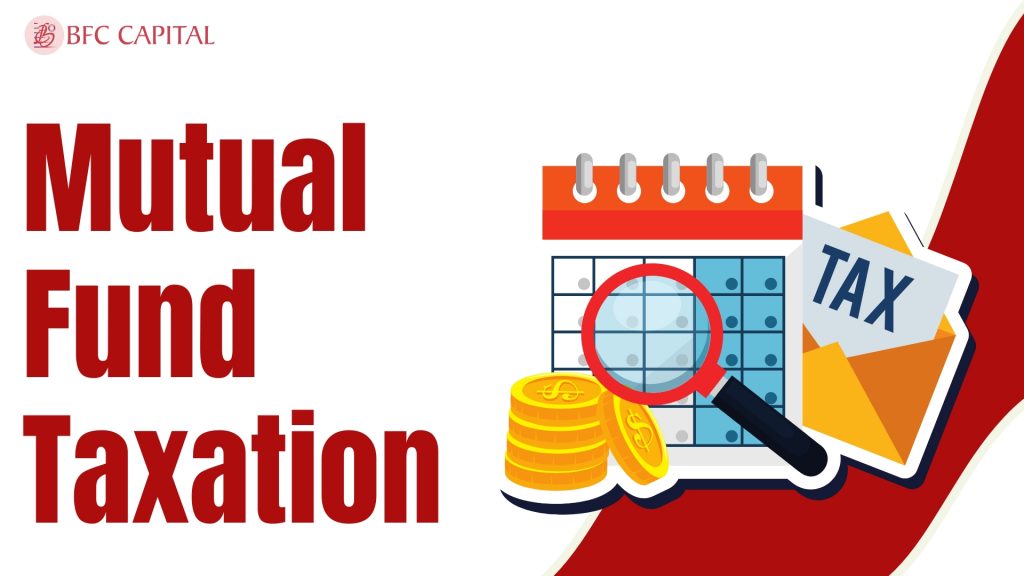
Understanding mutual funds’ tax implications in India can feel like jumping into a bottomless pit. Once you get used to it, this concept does not look as complex as it seemed before. And it’s definitely worth getting to know because the way your profits get taxed can affect your money plans. Whether you’re all about those equity funds that follow the stock market or you like the steady approach of debt funds, knowing the tax rules can help you make better choices about where to put your money.
Mutual Fund Taxation: The Basics
Before we embark on this journey together, let me remind you that the taxation amount on mutual funds comes down to two basic aspects: capital gains and dividends.
Capital gains: This is just a sophisticated term for the profit you receive after selling your units in mutual fund at an amount higher than its purchase price.
Now, capital gains—this is where things get interesting because the taxman treats them differently depending on how long you hold onto your investment and whether it’s in equity or debt funds.
Taxation of Equity Mutual Funds
These are the important ones, as most of our money is strangled around them in stocks.
Short-term capital gains are realized when the unit is sold within a year with 20% tax. However, if one waits for over a year, these profits become substantial long-term investments. But if you are patient and hold on for more than a year, the profit turns into a great long-term investment. The good news? The tax rate drops to 12.5%, and even better, you don’t pay any tax on the first ₹1.25 lakh of gains each year.
Example: Let’s say ₹2,00,000 was invested in an equity mutual fund, which yielded a return of ₹ 3,50,000 after 14 months. So basically, ₹1,50,000 profit. Since you waited for over a year, you get benefits of long-term capital gains tax regime. You don’t pay any tax on the first ₹1.25 lakh of long-term capital gains, so in this case, your profit of ₹1,25,000 is covered by the exemption. You pay tax on only ₹25,000 that too only 12.5%.
Taxation of Debt Mutual Funds
Now, let’s shift gears to debt mutual funds. The tax rules here are a bit different:
As of April 1, 2023, investors’ income tax slab rate determines the tax treatment of short-term capital gains made via debt mutual funds irrespective of the holding period of the investment. The indexation benefit which had helped in the past tax planning to defray costs of cgt (capital gain tax) will not be applicable for investments done on or after 1 April 2023.
Example: If you have invested ₹1,00,000 after April 1st, 2023, and the value increased to ₹1,50,000 by April 2, 2024, your gain of ₹50,000 would be taxed as short-term capital gain (since it’s held for less than 3 years) at your applicable income tax slab rate. If your slab rate is 30%, the tax on this gain would be as follows: 30% of ₹50,000 = ₹15,000.
In fact, if you have invested in debt mutual funds prior to April 1, 2023 and the investment is held for over 3 years it may not attract the new tax on them i.e. you can still have LTCG tax at 20% with indexation. However, this benefit will be materialized gradually and will be reduced over time.
Example: suppose before 1st April 2023 you have invested ₹5,00,000 in a debt fund and after four years you withdraw your money from the debt fund and you get ₹7,00,000. In case of indexation, you can actually purchase the asset for a new incremental value of ₹ 6,00,000. Hence it would be a taxable gain of ₹1,00,000. From that ₹1,00,000 gain then you subtract the 20% tax that will make it ₹20,000. This is much better than being taxed on ₹ 2,00,000 gain without indexation of the purchase price.
Taxation of Dividend Income
Amazingly, dividends received by investors were untaxed thanks to a levy known as the Dividend Distribution Tax (DDT) that was borne by the Indian Government. However, the situation has changed now. As of 2020, all dividends became part of your total income, which you would be taxed on according to your income level. Particularly, it hurts if you are in the uppermost tax level. Therefore, if a person lies in the tax bracket of 30% and receives a dividend of ₹1 lakh, then it is a must that he pays ₹30,000 tax on it.
Systematic Withdrawal Plan
Well, if you want a regular income but are not keen to see much of it go, say, in taxes, then there comes SWP. Instead of receiving a dividend, you can use the “Systematic Withdrawal Plan” to encash a portion of your mutual fund investment frequently. The beauty of this? The taxation of these withdrawals will depend on if they fall under either short-term or long-term capital gains tax. This is a little more flexible when it comes to taxes and which period you want to be charged on.
For instance, if you’re pulling out ₹10,000 a month and those units have been sitting there for one year in the case of equity mutual funds, you’re looking at long-term capital gains tax rates—definitely something worth considering.
Tax-Saving Mutual Funds (ELSS)
But how can we even forget the great Equity-Linked Savings Schemes (ELSS)? These are a good method to not only invest but also be able to reduce the amount of taxes to be paid. In the case of fixed deposits, you can invest up to ₹ 1. 5 lakhs through the ELSS fund, and the amount invested will be subtracted from the total income for coming under the tax bracket as per Section 80C. Besides, these funds come with the least lock-in period of three years, making it easier to invest in them as compared with other tax-saving instruments.
Imagine if your taxable income happened to be ₹10 lakhs only. Consequently, under this hypothetical situation, you would be inducing your taxable income to fall by ₹8,50,000 only when investing ₹1,50,000 that goes towards the ELSS fund. Hence, by doing so, not only do we save on taxes, but we may also reduce our tax brackets as well.
The Indexation Benefit: A Key Tool for Debt Investors
Indexation is one of those topics that appears complex but is actually rather straightforward in reality and pretty helpful, particularly if you’re investing in debt funds. They always want to tweak the base price of your mutual fund units to inflation, depending on which can cut down the taxable portion of your gains a lot.
Example: Suppose you invested in debt-mutual fund for ₹2,00,000 five years ago, and with inflation, the new Cost inflation index went from 200 to 300. Your cost index would be as follows:
₹2,00,000 X 300/200 = ₹3,00,000
That is how, if you are selling these units today for₹4,00,000. Your gain will be as follows-
₹4,00,000- ₹3,00,000= ₹1,00,000
So you will be paying taxes as per the ₹1,00,000 gain only instead of ₹2,00,000. Indeed, it is another way of saving a huge amount of taxes!
Conclusion: Making Tax-Efficient Investment Decisions
Yes, mutual fund taxation might sound complicated, but once you get these concepts in your head, these are not that difficult to deal with. But the most important thing in investing is the knowledge of the rules governing the payment of taxes, which goes a long way in helping in the decision-making process. If it’s an equity vs. debt fund, whether to take dividends or remain invested, or an SWP, the tax angle factors into your plan.
It is advised to consult a tax consultant so that the investment plans that you have in mind are in congruence with your financial objectives. One has to always be in sync with the tax laws—they evolve—and constantly revisit your asset base. If you take some time, you might be able to save a much bigger portion of your income earned across the week.
Please share your thoughts on this post by leaving a reply in the comments section. Contact us via Phone, WhatsApp, or Email to learn more about mutual funds, or visit our website. Alternatively, you can download the Prodigy Pro app to start investing today!
Disclaimer – This article is for educational purposes only and does not intend to substitute expert guidance. Mutual fund investments are subject to market risks. Please read the scheme-related document carefully before investing.

Assistant Vice President – Research & Analysis
Akash Gupta heads the Research & Analysis department at BFC CAPITAL, where he combines in-depth market insights with strategic analysis. He holds multiple certifications, including:
- NISM-Series-XIII: Common Derivatives Certification
- NISM-Series-VIII: Equity Derivatives Certification
- NISM-Series-XXI-A: Portfolio Management Services Certification
- IRDAI Certification
With his expertise in equity, derivatives, and portfolio management, Akash plays a key role in providing research-backed strategies and actionable insights to help clients navigate the investment landscape.






